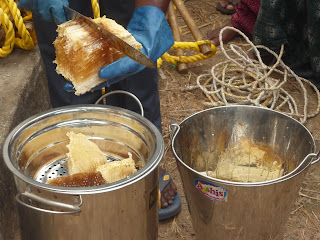 |
| JC and Rebecca present "Foundations in a Flash" to community animators. |
This week SST conducted a refresher training for all the field animators at the Padavedu site. We were asked to lead a brief lecture on social work practice in the United States. JC and I developed what I like to refer to as ‘foundations in a flash.’ We discussed strengths-based practice, client-centered approach, self-awareness, transaction theory, ecosystems perspective, and holistic approach. Self-awareness was the most challenging concept to embrace, which I think is true for most social service professionals. The process of becoming more self-aware requires reflection and insight beyond our time allotment and training ability. Our goal, however, was to introduce and share a few guiding principles from our studies. We wanted to emphasize the interconnectedness of various sectors across multiple levels of intervention. I was unsure how these theories would translate (literally and figuratively) in another culture but animators were quick to participate and share examples from their practice.
During our planning I was concerned our training might come across as common sense, but then I realized how easy it is to forget. At field placement I found myself distracted by immediate concerns: does this person have housing, what is their affect, is this child safe, etc. It is a constant struggle, especially as a direct practice student, to remind myself that immediate crisis’ are correlated to community, policy and cultural ramifications. In class the connection is clear, however, in field I rarely examine the larger implications. This is the Achilles heel of social work. I worry that direct practice narrow-mindedly fixates on the (dis)functioning of an individual without addressing the root cause. Even if the practitioner recognizes the macro-level connection, are direct practice positions malleable enough to encompass community development? My experience here has strengthened my interest in community organizing and confirmed its importance in empowering others. I feel my challenge upon returning will be to fuse community development and direct practice in a meaningful way.
My favorite part of our mini-lecture was when we posed the question ‘how does society benefit from self-help groups’ to the animators. An eager hand decorated with gold bangles shot up and explained that SHGs empower women. Such a simple, almost obvious answer, but the weight of that statement in the context of transforming an entire culture reminded me that nothing is fixed.











